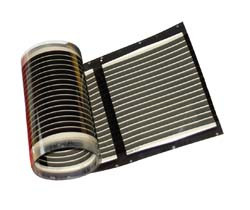Advanced organic solar cells
The first generation of solar devices to convert the Sun's energy to electricity was based on crystalline silicon materials. The second generation is based on thin-film technology. Thin-film solar cells (TFSCs) are made by depositing a thin film of highly photosensitive inorganic semiconductor material such as cadmium telluride (CdTe) or amorphous silicon (a-Si) or copper indium gallium selenide (CIS/CIGS) on a substrate. However high materials and manufacturing costs in both these semiconductor systems limit widespread application. The third generation, still in the lab, is applying novel materials, device concepts and fabrication methods to TFSC technology to further reduce costs and achieve even higher efficiencies. Polymer-based (organic) solar cells and hybrid (organic polymers-inorganic nanoparticles) systems promise reduced costs as they are suitable to modern fabrication methods such as roll-to-roll (R2R) processing. A European consortium developed a number of conjugated polymers to be used as donor and acceptor systems in third-generation organic solar cells with EU funding of the LARGECELLS(opens in new window) (Large-area organic and hybrid solar cells) project. Optimisation at lab scale doubled the power conversion efficiency (PCE) of a single donor/acceptor junction device to 7.4 %, with 4 % PCE achieved in a R2R printable device. Tandem and triple-junction polymer-fullerene (nanocarbon) solar cells had PCEs of 8.9 % and 9.6 %, respectively. In addition, scientists replaced the expensive ITO with transparent metal grid or graphite networks with no adverse effect on transmission or conductivity. In upscaling to R2R technology, the team investigated a number of potential techniques, including screen printing and inkjet. Careful consideration was given not only to the integrity and function of the active layer, but also to the silver backside electrode that plays a critical role in performance. Organic PV cells are sensitive to oxygen and water, so several lamination technologies to increase durability were investigated. Set-ups for stability testing were installed to evaluate both normal (outdoor) operating conditions and indoor accelerated ageing. Great effort has focused on dissemination of this breakthrough technology through public media and scientific channels. With novel materials for organic and hybrid TFSCs scalable for R2R processing, LARGECELLS should significantly increase efficiency while decreasing costs. This promises to make clean solar energy a truly viable alternative to current fossil fuel-derived electricity.







